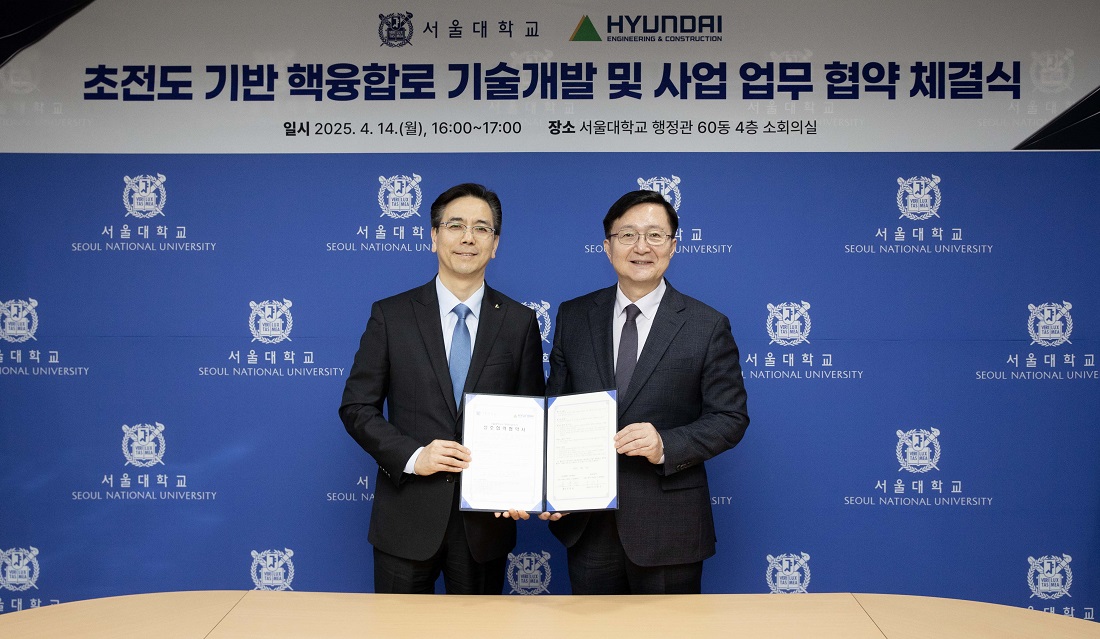Press Release
Building an Industry-Academia Cooperation Framework for the Development of ‘Dream Energy,’ Nuclear Fusion
▲ Signed a Memorandum of Understanding on Monday, November 14th, for the development of superconductor-based fusion reactor technology and business cooperation
▲ Focusing on sustainable energy innovation through nuclear fusion, the new paradigm in nuclear power generation

Hyundai E&C is proactively moving to secure technological and business capabilities to enhance its competitiveness in the field of nuclear fusion power, which is gaining new attention as the energy source of the future.
On Monday, November 14th, Hyundai E&C signed a Memorandum of Understanding with Seoul National University for the ‘Development of Superconductor-Based Fusion Reactor Technology and Business Cooperation.’ The signing ceremony was held at Seoul National University’s Gwanak Campus, attended by key officials including Hyundai E&C CEO Lee Han-woo and Seoul National University President Ryu Hong-lim.
Nuclear fusion is a technology that produces energy by heating fuel, such as hydrogen, to an ultra-high temperature of over 100 million degrees Celsius in a plasma1) state, causing atomic nuclei to fuse. It is called the ‘dream energy’ source because the fuel needed for nuclear fusion is abundant, the risk of explosion is low, and it generates minimal emissions and radioactive waste.
The core of the fusion process is to maintain the ultra-high-temperature plasma in a stable state for an extended period. The powerful magnetic field of a superconducting magnet serves to confine this plasma, and superconductors, special materials that have zero electrical resistance under specific conditions, are needed to build this magnet. Given the immense potential of nuclear fusion as a next-generation energy source, major institutions and corporations worldwide are currently engaged in related large-scale projects and are diligently pursuing research and development to solve these advanced technical challenges.
Seoul National University is leading the way in advancing fusion technology through intensive research. It has developed source technologies that can miniaturize fusion systems, such as non-insulated high-temperature superconductors, and is participating in the world's first commercial fusion power project, the Spherical Tokamak for Energy Production (STEP), organized by the United Kingdom Atomic Energy Authority (UKAEA).
With this agreement as a foundation, Hyundai E&C and Seoul National University plan to closely cooperate on △joint research and technology development/transfer, △business development and engagement, and △personnel support and the operation of a joint consultative body for superconductor-based fusion reactors and fusion superconductors at home and abroad. Based on its experience in various plant projects, including large-scale nuclear power plants and SMRs, Hyundai E&C will play a leading role in the construction and commercialization of fusion power plants. Seoul National University will accelerate its research on core technologies in the fields of nuclear fusion and superconductivity, creating a synergy based on the unique capabilities of both institutions to lead future energy innovation.
Hyundai E&C CEO Lee Han-woo commented, “We expect the cooperation between the leading institutions of Korea’s industry and academia to drive a new engine for the upcoming energy transition.” He added, “Today's agreement marks a meaningful occasion that will allow fusion power to move from the laboratory to the construction of demonstration and commercial reactors, thereby creating tangible value.”
Seoul National University President Ryu Hong-lim also noted, “This agreement will become an important milestone in the history of superconductor research in Korea.” He later added, “I hope that through the cooperation of our two institutions, we will ensure Korea secures world-leading technology and contribute to the strengthening national competitiveness.”
1) The fourth state of matter, beyond solid, liquid, and gas — where positively charged atomic nuclei and negatively charged free electrons exist separately.


